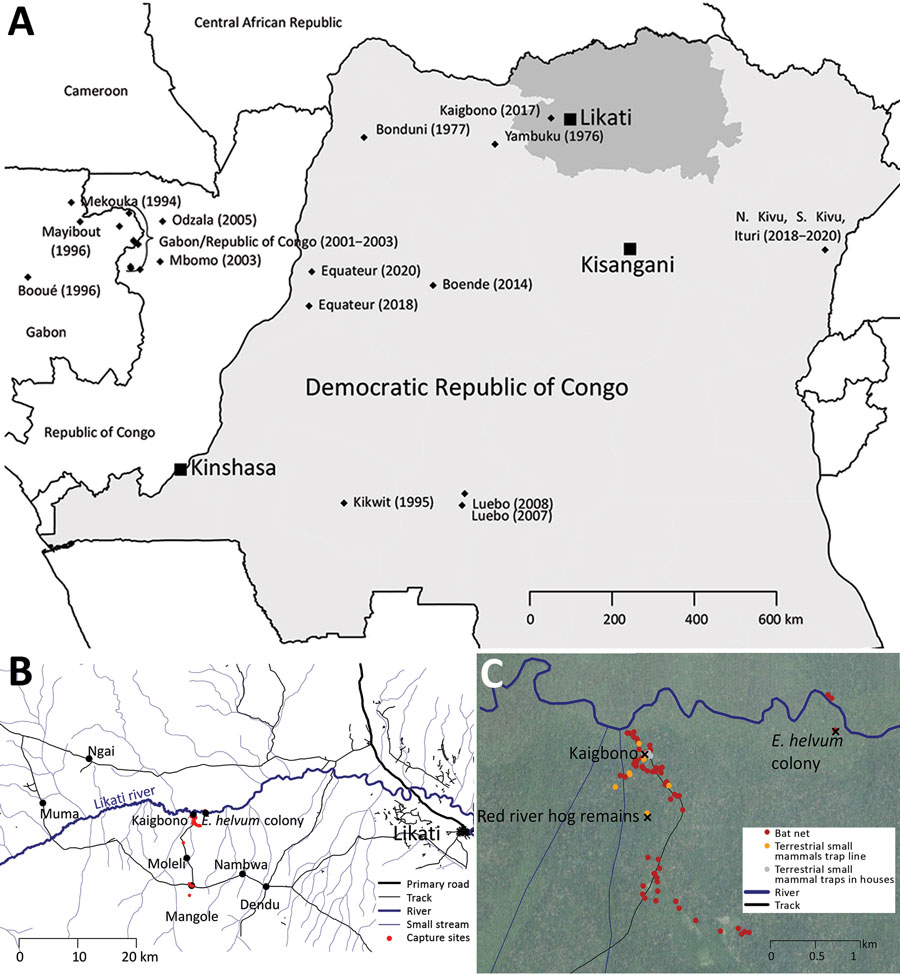Role of Wildlife in Emergence of Ebola Virus in Kaigbono (Likati), Democratic Republic of the Congo, 2017
Sophie Gryseels
1
, Placide Mbala-Kingebeni
1, Innocent Akonda, Roger Angoyo, Ahidjo Ayouba, Pascal Baelo, Daniel Bamuleka Mukadi, Elie Bugentho, Trenton Bushmaker, Christelle Butel, Sébastien Calvignac-Spencer, Eric Delaporte, Birgit De Smet, Ariane Düx, François Edidi-Atani, Robert Fischer, Corneille Kahandi, Jimmy Kapetshi, Servet Kimbonza Sumba, Léonce Kouadio, André Malekani Bendeke, Claude Mande, Guy Midingi Sepolo, Joseph Moudindo, Eitel Mpoudi Ngole, Prescott Musaba, Patrick Mutombo, Innocent Ndong Bass, Casimir Nebesse, Steve Ngoy, Simon-Pierre Ndimbo Kumogo, Stephanie N. Seifert, Jacques Tanzito, Dudu Akaibe, Nicaise Amundala, Kevin K. Ariën, Guy-Crispin Gembu, Fabian H. Leendertz, Herwig Leirs, Jean-Claude Mukinzi, Vincent Munster, Jean-Jacques Muyembe-Tamfum, Martine Peeters, Erik Verheyen, and Steve Ahuka-Mundeke
Author affiliations: University of Arizona, Tucson, Arizona, USA (S. Gryseels); KU Leuven, Leuven, Belgium (S. Gryseels); University of Antwerp, Antwerp, Belgium (S. Gryseels, H. Leirs, E. Verheyen); Université de Montpellier, Montpellier, France (P. Mbala-Kingebeni, A. Ayouba, C. Butel, E. Delaporte, J. Moudindo, E. Mpoudi Ngole, I. Ndong Bass, M. Peeters); Institut National de Recherche Biomédicale, Kinshasa, Democratic Republic of the Congo (P. Mbala-Kingebeni, F. Edidi-Atani, J. Kapetshi, S. Kimbonza Sumba, G. Midingi Sepolo, D. Bamuleka Mukadi, S.P. Ndimbo Kumogo, J.J. Muyembe-Tamfum, S. Ahuka-Mundeke); Division Provinciale de la Sante, Buta (Bas-Uele), Democratic Republic of the Congo (I. Akonda); Programme National de Lutte Contre le Sida, Buta (I. Akonda); Centre de Surveillance de la Biodiversité, Kisangani, Democratice Republic of the Congo (R. Angoyo, P. Baelo, E. Bugentho, C. Kahandi, A. Malekani Bendeke, C. Mande, P. Musaba, P. Mutombo, C. Nebesse, S. Ngoy, J. Tanzito, D. Akaibe, N. Amundala, G.C. Gembu, J.C. Mukinzi); National Institutes of Health, Hamilton, Montana, USA (T. Bushmaker, R. Fischer, S.N. Seifert, V. Munster); Robert Koch Institute, Berlin, Germany (S. Calvignac-Spencer, A. Düx, L. Kouadio, D. Bamuleka Mukadi, F.H. Leendertz); Institute of Tropical Medicine, Antwerp (B. De Smet, K.K. Ariën); Laboratoire Central de la Pathologie Animale, Bingerville, Côte d’Ivoire (L. Kouadio); University of Kisangani, Kisangani (C. Mande, P. Musaba, C. Nebesse, D. Akaibe, N. Amundala, G.C. Gembu, J.C. Mukinzi); Centre de Recherches sur les Maladies Émergentes, Re-émergentes et la Médecine Nucléaire, Yaoundé, Cameroon (J. Moudindo, E. Mpoudi Ngole, I. Ndong Bass); Royal Belgian Institute of Natural Sciences, Brussels, Belgium (E. Verheyen)
Main Article
Figure 1

Figure 1. Locations of human Ebola virus (EBOV) outbreaks in Central Africa and capture site of potential wildlife reservoirs in study of role of wildlife in emergence of Ebola virus, Democratic Republic of the Congo, 2017. A) Reported human EBOV outbreaks in central Africa. Diamonds indicate the approximate locations where each outbreak started. Outbreak year(s) are shown in brackets. Bas-Uele province is highlighted in dark gray. B) Overview of the area where the 2017 EBOV outbreak occurred (Likati Health Zone, Bas-Uele, Democratic Republic of the Congo). Black dots indicate villages and Eidolon helvum bat colony; red dots indicate sites where mammals were captured in this study. C) Study area at and around Kaigbono village, with most capture sites indicated.
Main Article
Page created: May 27, 2020
Page updated: August 19, 2020
Page reviewed: August 19, 2020
The conclusions, findings, and opinions expressed by authors contributing to this journal do not necessarily reflect the official position of the U.S. Department of Health and Human Services, the Public Health Service, the Centers for Disease Control and Prevention, or the authors' affiliated institutions. Use of trade names is for identification only and does not imply endorsement by any of the groups named above.
